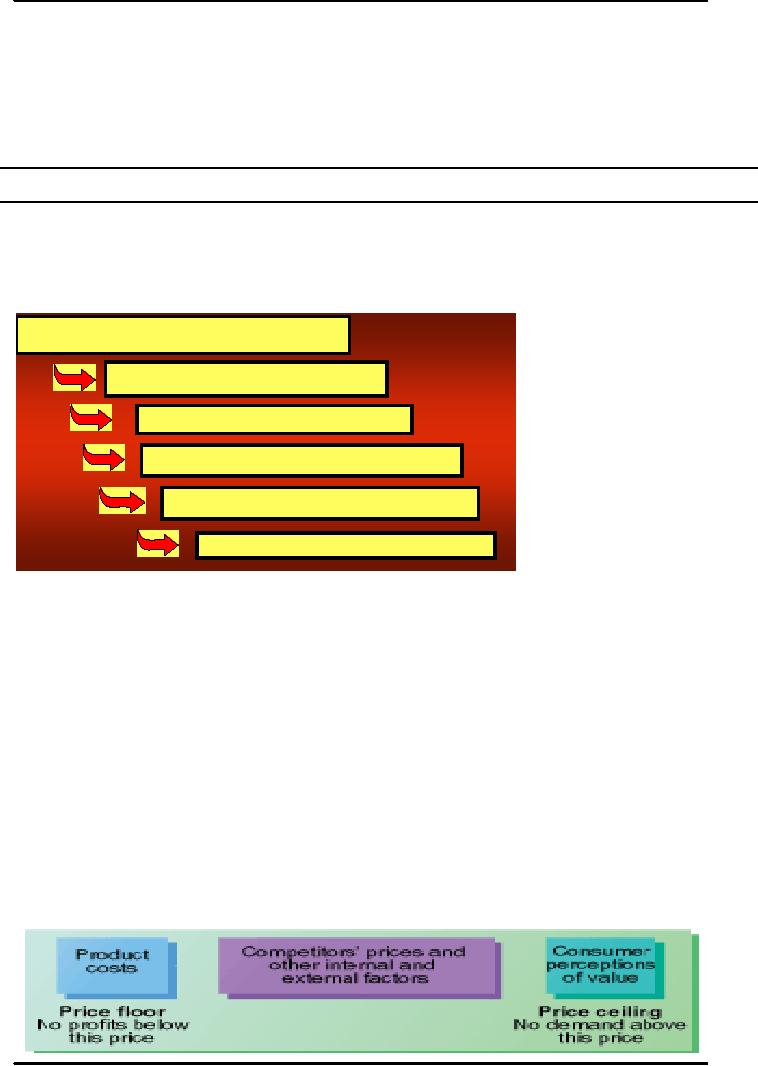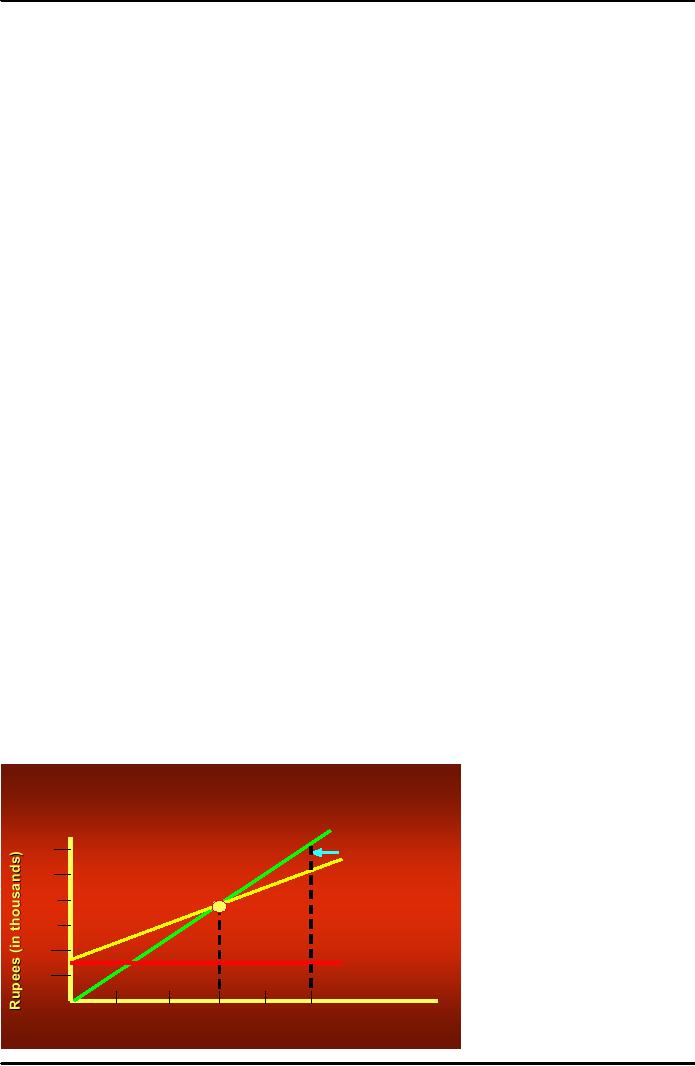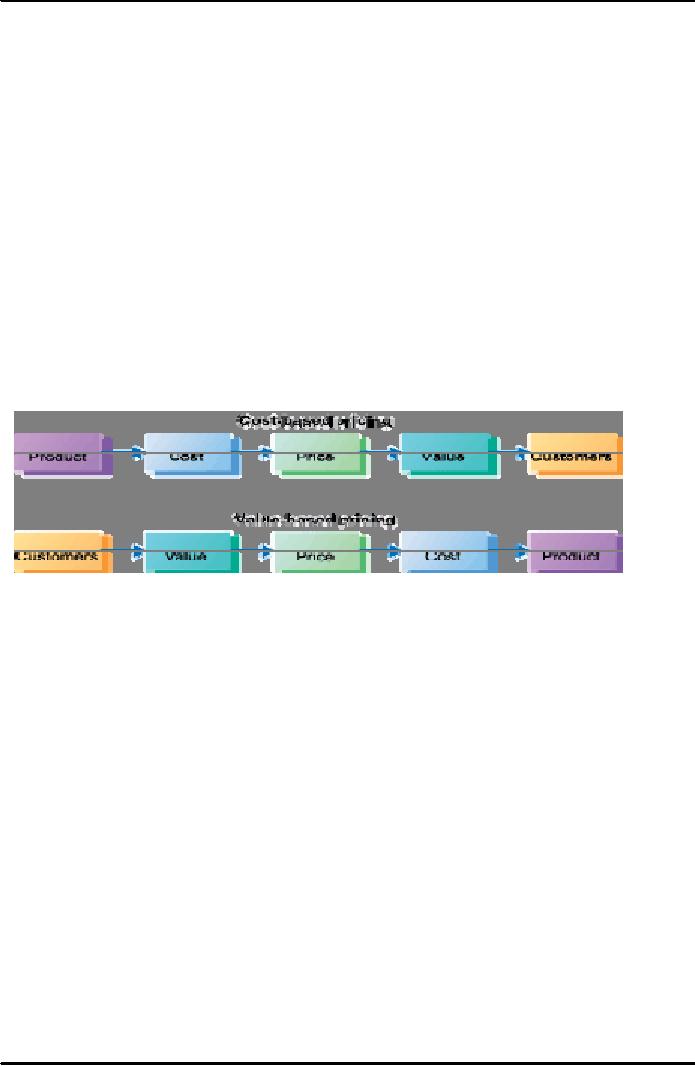 |

Principles
of Marketing MGT301
VU
Lesson
25
Lesson
overview and learning objectives:
In
last Lesson we discussed the
price its definition, focused on
the problem of setting prices
and
considered
the factors marketers must
consider when setting prices today we
will look at general
pricing
approaches, we will also
examine pricing strategies
for new-product pricing,
product mix
pricing.
PRICE
THE 2ND P OF MARKETING MIX.
A.
Setting
Pricing Policy
Pricing
policy setting starts with setting
the pricing objective that
can be: Profit
Oriented
(concerned
with increase in profit),
Sales Oriented (basically concerned
with increase in sales)
and
Status
Quo Oriented. Whereas costs
set the lower limit of
prices, the market and
demand set the
upper
limit.
Both
consumer
and industrial
1
. S e le c tin g t h e p r ic in g o b je c tiv e
buyers
balance the price
of
a product or service
2
. D e te r m in in g d e m a n d
against
the benefits of
owning
it. Thus, before
3
. E s tim a tin g c o s ts
setting
prices,
the
marketer
must
4
. A n a ly z in g c o m p e tito r s '
c
o s ts , p r ic e s , a n d o ffe r s
understand
the
relationship
between
5
. S e le c tin g a p r ic in g m e th o d
price
and demand for its
product.
In this section,
6
. S e le c tin g fin a l p r ic e
we
explain how
the
pricedemand
relationship
varies for different types
of markets and how buyer
perceptions of price affect
the
pricing
decision. Costs set the
floor for the price
that the company can
charge for its product.
The
company
wants to charge a price that
both covers all its costs
for producing, distributing,
and
selling
the product and delivers a
fair rate of return for its
effort and risk. A company's costs
may
be
an important element in its pricing strategy.
Companies with lower costs
can set lower
prices
that
result in greater sales and
profits. Company's pricing decisions
are also affected by
competitors'
costs and prices and
possible competitor reactions to
the company's own
pricing
moves
there fore while setting the
prices theses facts should
also kept in mind. Final
step is setting
the
final price by using different
methods.
B.
General Pricing Approaches
The
price the company charges
will be somewhere between one
that is too low to produce a
profit
and
one that is too high to produce any
demand. Figure summarizes the
major considerations in
setting
price. Product costs set a
floor to the price; consumer perceptions
of the product's value
set
the
ceiling. The company must
consider competitors' prices
and other external and
internal factors
to
find the best price
between these two extremes.
Companies set prices by
selecting a general
119

Principles
of Marketing MGT301
VU
pricing
approach that includes one or more of
three sets of factors. We examine
these approaches:
the
cost-based
approach (cost-plus
pricing, break-even analysis,
and target profit pricing);
the buyer-
based
approach (value-based
pricing); and the competition-based
approach (going-rate
and sealed-bid
pricing).
a)
Cost-Based Pricing
Cost-Plus
Pricing
The
simplest pricing method is
cost-plus pricing--adding a standard
markup to the cost of
the
product.
Construction companies, for
example, submit job bids by
estimating the total project
cost
and
adding a standard markup for
profit. Lawyers, accountants, and
other professionals
typically
price
by adding a standard markup to
their costs. Some sellers
tell their customers they
will charge
cost
plus a specified markup; for
example, aerospace companies
price this way to the
government.
To
illustrate markup pricing,
suppose any manufacturer had
the following costs and
expected sales:
Then
the manufacturer's cost per
toaster is given by:
Unit
Cost = variable Cost + Fixed
Cost
---------------
Price
- Variable Cost
The
manufacturer's markup price is given
by:
Markup
Price
=
Unit
Cost
---------------
(1-desired
return on sale)
Do
using standard markups to set prices
make sense? Generally, no.
Any pricing method
that
ignores
demand and competitor prices
is not likely to lead to the
best price. Markup pricing
works
only
if that price actually brings in
the expected level of sales.
Still, markup pricing
remains popular
for
many reasons. First, sellers
are more certain about costs
than about demand. By tying
the price
to
cost, sellers simplify
pricing--they do not have to
make frequent adjustments as
demand
changes.
Second, when all firms in
the industry use this
pricing method, prices tend
to be similar
and
price competition is thus
minimized. Third, many
people feel that cost-plus
pricing is fairer to
both
buyers and sellers. Sellers
earn a fair return on their
investment but do not take
advantage of
buyers
when buyers' demand becomes
great.
Break-even
Analysis and Target Profit
Pricing
Another
cost-oriented pricing approach is
break-even pricing(or a variation
called target profit
pricing
he firm tries to determine the
price at which it will break
even or make the target
profit it is
seeking.
This pricing method is also
used by public utilities,
which are constrained to make a
fair
return
on their investment.
Target
pricing uses the
concept
of
a break-even
chart, which
T
o ta l re v e n u e
shows
the total cost and
total
T
a rg e t p ro fit
1200
revenue
expected at different
T
o ta l c o s t
sales
volume levels. Figure
1000
B
r e a k -e v e n p o in t
shows
a break-even point.
800
Fixed
costs are same
regardless
600
of
sales volume. Variable
costs
400
are
added to fixed costs
to
F
ix e d c o s t
form
total costs, which
rise
200
with
volume. The total
revenue
0
curve
starts at zero and
rises
10
20
30
40
50
S
a le s v o l u m e in u n it s ( t h o u s a n d s )
with
each unit sold.
120

Principles
of Marketing MGT301
VU
Fixed
Cost
Break-even
Volume =
---------------
Price
- Variable Cost
The
manufacturer should consider
different prices and
estimate break-even volumes,
probable
demand,
and profits for
each.
b)
Value-Based Pricing
An
increasing number of companies
are basing their prices on
the product's perceived
value.
Value-based
pricing uses buyers' perceptions of value,
not the seller's cost, as
the key to pricing.
Value-based
pricing means that the
marketer cannot design a product
and marketing program and
then
set the price. Price is
considered along with the
other marketing mix variables
before
the
marketing
program is set.
Figure
compares cost-based pricing
with value-based pricing.
Cost-based pricing is product
driven.
The
company designs what it
considers to be a good product,
totals the costs of making
the
product,
and sets a price that
covers costs plus a target
profit. Marketing must then
convince
buyers
that the product's value at
that price justifies its
purchase. If the price turns
out to be too
high,
the company must settle
for lower markups or lower
sales, both resulting in
disappointing
profits.
Cost-based
versus value-based
pricing
Value-based
pricing reverses this
process. The company sets
its target price based on
customer
perceptions
of the product value. The
targeted value and price
then drive decisions about
product
design
and what costs can be
incurred. As a result, pricing
begins with analyzing consumer
needs
and
value perceptions, and price is set to
match consumers' perceived value.
A
company using value-based pricing
must find out what value
buyers assign to different
competitive
offers. However, measuring
perceived value could be difficult.
Sometimes, consumers
are
asked how much they
would pay for a basic
product and for each
benefit added to the
offer.
Or
a company might conduct experiments to
test the perceived value of
different product
offers.
If
the seller charges more
than the buyers' perceived value,
the company's sales will
suffer. Many
companies
overprice their products, and
their products sell poorly.
Other companies under
price.
Under
priced products sell very
well, but they produce less
revenue than they would have
if price
were
raised to the perceived-value
level.
During
the past decade, marketers
have noted a fundamental
shift in consumer attitudes toward
price
and quality. Many companies
have changed their pricing
approaches to bring them
into line
with
changing economic conditions and consumer
price perceptions. The best way to
hold your
customers
is to constantly figure out
how to give them more
for less."
Thus,
more and more, marketers
have adopted value pricing
strategies--offering just the
right
combination
of quality and good service
at a fair price. In many
cases, this has involved
the
introduction
of less expensive versions of
established, brand-name products. In many
business-to-
business
marketing situations, the pricing
challenge is to find ways to
maintain the company's
121

Principles
of Marketing MGT301
VU
pricing
power--its
power to maintain or even
raise prices without losing market
share. To retain
pricing
power--to escape price
competition and to justify
higher prices and margins--a
firm must
retain
or build the value of its marketing
offer. This is especially
true for suppliers of
commodity
products,
which are characterized by
little differentiation and
intense price competition. In
such
cases,
many companies adopt value-added
strategies.
Rather than cutting prices
to match
competitors,
they attach value-added services to
differentiate their offers
and thus support
higher
margins.
c)
Competition-Based Pricing
Consumers
will base their judgments of
a product's value on the prices
that competitors charge
for
similar
products. One form of competition-based
pricing is going-rate
pricing, in
which a firm bases
its
price largely on competitors' prices,
with less attention paid to
its own costs or to demand.
The
firm
might charge the same,
more, or less than its major
competitors. In oligopolistic
industries
that
sell a commodity such as steel,
paper, or fertilizer, firms
normally charge the same
price. The
smaller
firms follow the leader:
They change their prices
when the market leader's
prices change,
rather
than when their own
demand or costs change. Some
firms may charge a bit
more or less,
but
they hold the amount of
difference constant. Thus, minor
gasoline retailers usually
charge a
few
cents less than the
major oil companies, without
letting the difference
increase or decrease.
Going-rate
pricing is quite popular.
When demand elasticity is hard to
measure, firms feel that
the
going
price represents the
collective wisdom of the
industry concerning the
price that will yield
a
fair
return. They also feel that
holding to the going price
will prevent harmful price
wars.
Competition-based
pricing is also used when
firms bid
for
jobs. Using sealed-bid
pricing, a firm
bases
its
price on how it thinks
competitors will price
rather than on its own costs
or on the demand.
The
firm wants to win a contract,
and winning the contract
requires pricing less than
other firms.
Yet
the firm cannot set its
price below a certain level. It
cannot price below cost
without harming
its
position. In contrast, the
higher the company sets its
price above its costs, the
lower its chance
of
getting the contract.
Pricing
decisions are subject to an incredibly
complex array of environmental
and competitive
forces.
A company sets not a single
price, but rather a
pricing
structure that
covers different items
in
its
line. This pricing structure
changes over time as
products move through their
life cycles. The
company
adjusts product prices to
reflect changes in costs and
demand and to account
for
variations
in buyers and situations. As the
competitive environment changes,
the company
considers
when to initiate price
changes and when to respond to
them.
C.
New-Product Pricing
Strategies
Pricing
strategies usually change as
the product passes through
its life cycle. The
introductory stage
is
especially challenging. Companies
bringing out a new product
face the challenge of setting
prices
for
the first time. They
can choose between two broad
strategies: market-skimming
pricing and
market-
penetration
pricing.
a)
Market-Skimming Pricing
Many
companies that invent new
products initially set high
prices to "skim" revenues
layer by layer
from
the market. Intel is a prime
user of this strategy, called
market-skimming
pricing.
Market
skimming
makes sense only under
certain conditions. First, the
product's quality and image
must
support
its higher price, and enough
buyers must want the product
at that price. Second, the
costs
of
producing a smaller volume cannot be so
high that they cancel
the advantage of charging
more.
Finally,
competitors should not be
able to enter the market
easily and undercut the
high price.
b)
Market-Penetration
Pricing
Rather
than setting a high initial
price to skim
off
small but profitable market segments,
some
companies
use market-penetration
pricing.
They set a low initial
price in order to penetrate
the
market
quickly and deeply--to
attract a large number of buyers
quickly and win a large
market
share.
The high sales volume
results in falling costs, allowing
the company to cut its price
even
122

Principles
of Marketing MGT301
VU
further.
Several conditions must be
met for this low-price
strategy to work. First, the
market must
be
highly price sensitive so
that a low price produces
more market growth. Second,
production and
distribution
costs must fall as sales
volume increases. Finally,
the low price must
help keep out
the
competition,
and the penetration pricer
must maintain its low-price
position--otherwise, the
price
advantage
may be only
temporary.
D.
Product Mix Pricing Strategies
The
strategy for setting a product's
price often has to be
changed when the product is
part of a
product
mix. In this case, the
firm looks for a set of
prices that maximizes the
profits on the total
product
mix. Pricing is difficult because
the various products have
related demand and costs
and
face
different degrees of competition. We
now take a closer look at
the five product mix
pricing
situations
a)
Product Line Pricing
Companies
usually develop product lines
rather than single products.
In product line
pricing,
management
must decide on the price
steps to set between the
various products in a line.
The
price steps should take
into account cost differences
between the products in the
line,
customer
evaluations of their different features,
and competitors' prices. In
many industries, sellers
use
well-established price
points for
the products in their line.
The seller's task is to
establish
perceived
quality differences that support
the price differences.
b)
Optional-Product Pricing
Many
companies use optional-product
pricing--offering to sell optional or
accessory products
along
with their main product.
For example, a car buyer
may choose to order power
windows,
cruise
control, and a CD changer. Pricing these
options is a sticky problem. Automobile
companies
have
to decide which items to
include in the base price
and which to offer as
options. Until recent
years,
The economy model was
stripped of so many comforts and
conveniences that most
buyers
rejected
it.
c)
Captive-Product Pricing
Companies
that make products that
must be used along with a
main product are using
captive-
product
pricing. Examples of captive products are
razor blades, camera film,
video games, and
computer
software. Producers of the main
products (razors, cameras, video game
consoles, and
computers)
often price them low
and set high markups on the
supplies. Thus,
camera
manufactures
price its cameras low
because they make its money
on the film it sells. In the
case of
services,
this strategy is called
two-part
pricing. The
price of the service is
broken into a fixed
fee plus
a
variable
usage rate. Thus,
a telephone company charges a monthly
rate--the fixed fee--plus
charges
for
calls beyond some minimum
number--the variable usage
rate. Amusement parks
charge
admission
plus fees for food,
midway attractions, and rides
over a minimum. The service
firm must
decide
how much to charge for
the basic service and
how much for the
variable usage. The
fixed
amount
should be low enough to induce
usage of the service; profit
can be made on the
variable
fees.
d)
By-Product Pricing
In
producing processed meats,
petroleum products, chemicals,
and other products, there
are often
by-products.
If the by-products have no value
and if getting rid of them is
costly, this will
affect
the
pricing of the main product.
Using by-product pricing,
the manufacturer will seek a
market for
these
by-products and should
accept any price that covers
more than the cost of
storing and
delivering
them. This practice allows
the seller to reduce the
main product's price to make
it more
competitive.
By-products can even turn
out to be profitable. For
example, many lumber mills
have
begun
to sell bark chips and
sawdust profitably as decorative
mulch for home and
commercial
landscaping.
Sometimes,
companies don't realize how
valuable their by-products
are.
123

Principles
of Marketing MGT301
VU
e)
Product
Bundle Pricing
Using
product bundle pricing,
sellers often combine several of
their products and offer
the bundle
at
a reduced price. Thus,
theaters and sports teams
sell season tickets at less
than the cost of
single
tickets;
hotels sell specially priced
packages that include room,
meals, and entertainment;
computer
makers
include attractive software packages
with their personal computers.
Price bundling can
promote
the sales of products consumers
might not otherwise buy, but
the combined price
must
be
low enough to get them to
buy the bundle.
124
Table of Contents:
- PRINCIPLES OF MARKETING:Introduction of Marketing, How is Marketing Done?
- ROAD MAP:UNDERSTANDING MARKETING AND MARKETING PROCESS
- MARKETING FUNCTIONS:CUSTOMER RELATIONSHIP MANAGEMENT
- MARKETING IN HISTORICAL PERSPECTIVE AND EVOLUTION OF MARKETING:End of the Mass Market
- MARKETING CHALLENGES IN THE 21st CENTURY:Connections with Customers
- STRATEGIC PLANNING AND MARKETING PROCESS:Setting Company Objectives and Goals
- PORTFOLIO ANALYSIS:MARKETING PROCESS,Marketing Strategy Planning Process
- MARKETING PROCESS:Analyzing marketing opportunities, Contents of Marketing Plan
- MARKETING ENVIRONMENT:The Company’s Microenvironment, Customers
- MARKETING MACRO ENVIRONMENT:Demographic Environment, Cultural Environment
- ANALYZING MARKETING OPPORTUNITIES AND DEVELOPING STRATEGIES:MIS, Marketing Research
- THE MARKETING RESEARCH PROCESS:Developing the Research Plan, Research Approaches
- THE MARKETING RESEARCH PROCESS (Continued):CONSUMER MARKET
- CONSUMER BUYING BEHAVIOR:Model of consumer behavior, Cultural Factors
- CONSUMER BUYING BEHAVIOR (CONTINUED):Personal Factors, Psychological Factors
- BUSINESS MARKETS AND BUYING BEHAVIOR:Market structure and demand
- MARKET SEGMENTATION:Steps in Target Marketing, Mass Marketing
- MARKET SEGMENTATION (CONTINUED):Market Targeting, How Many Differences to Promote
- Product:Marketing Mix, Levels of Product and Services, Consumer Products
- PRODUCT:Individual product decisions, Product Attributes, Branding
- PRODUCT:NEW PRODUCT DEVELOPMENT PROCESS, Idea generation, Test Marketing
- NEW PRODUCT DEVELOPMENT:PRODUCT LIFE- CYCLE STAGES AND STRATEGIES
- KEY TERMS:New-product development, Idea generation, Product development
- Price the 2nd P of Marketing Mix:Marketing Objectives, Costs, The Market and Demand
- PRICE THE 2ND P OF MARKETING MIX:General Pricing Approaches, Fixed Cost
- PRICE THE 2ND P OF MARKETING MIX:Discount and Allowance Pricing, Segmented Pricing
- PRICE THE 2ND P OF MARKETING MIX:Price Changes, Initiating Price Increases
- PLACE- THE 3RD P OF MARKETING MIX:Marketing Channel, Channel Behavior
- LOGISTIC MANAGEMENT:Push Versus Pull Strategy, Goals of the Logistics System
- RETAILING AND WHOLESALING:Customer Service, Product Line, Discount Stores
- KEY TERMS:Distribution channel, Franchise organization, Distribution center
- PROMOTION THE 4TH P OF MARKETING MIX:Integrated Marketing Communications
- ADVERTISING:The Five M’s of Advertising, Advertising decisions
- ADVERTISING:SALES PROMOTION, Evaluating Advertising, Sales Promotion
- PERSONAL SELLING:The Role of the Sales Force, Builds Relationships
- SALES FORCE MANAGEMENT:Managing the Sales Force, Compensating Salespeople
- SALES FORCE MANAGEMENT:DIRECT MARKETING, Forms of Direct Marketing
- DIRECT MARKETING:PUBLIC RELATIONS, Major Public Relations Decisions
- KEY TERMS:Public relations, Advertising, Catalog Marketing
- CREATING COMPETITIVE ADVANTAGE:Competitor Analysis, Competitive Strategies
- GLOBAL MARKETING:International Trade System, Economic Environment
- E-MARKETING:Internet Marketing, Electronic Commerce, Basic-Forms
- MARKETING AND SOCIETY:Social Criticisms of Marketing, Marketing Ethics
- MARKETING:BCG MATRIX, CONSUMER BEHAVIOR, PRODUCT AND SERVICES
- A NEW PRODUCT DEVELOPMENT:PRICING STRATEGIES, GLOBAL MARKET PLACE